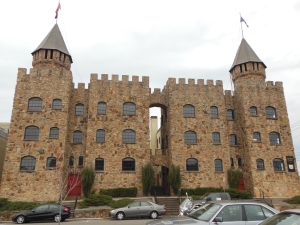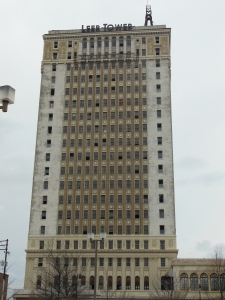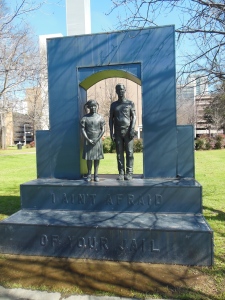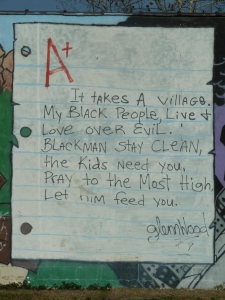For those of you who aren’t very familiar with our city, I thought that you may enjoy a bit of a photographic tour. These images are the landmarks that make us who we are; they’re the things that make us unique.
The Vulcan Statue is generally considered to be the symbol of Birmingham. It was sculpted, begining in 1903 by Italian sculptor Giuseppe Moretti. He was Birmingham’s entry for the 1904 World’s Fair in St. Louis. Vulcan was the god of the fire and the forge in Roman mythology. Since 1936 Vulcan has stood watch over the city from his perch atop Red Mountain. Symbolizing the city’s founding on the iron and steel industry, he is made from iron ore mined from the very mountain on which he stands. At 56 feet, he is the tallest cast iron statue on Earth and is the 7th tallest free standing statue in the United States.
But Vulcan isn’t the only cool statue in Birmingham. “Miss Electra” has adorned the top of the  Alabama Power building since 1926. Unlike Vulcan who is partially clothed, Miss Electra is totally nude and has lighting bolts for hair and bolts in her hands.
Alabama Power building since 1926. Unlike Vulcan who is partially clothed, Miss Electra is totally nude and has lighting bolts for hair and bolts in her hands.
A replica of Leonardo Da Vinci’s Vitruvian Man greets visitors to the Medical Forum in downtown Birmingham.
Once known as the “Football Capital of the South” Birmingham’s Legion Field has been home to some legendary games involving the Alabama Crimson Tide and the Auburn Tigers. For many years it was the largest stadium in the state and the Tide and the Tigers usually chose to play their biggest, most important home games here. Up until the last few years of the 20th century, the Tide and Tigers always played each other here. That’s why the label “Iron Bowl” became associated with the huge rivalry. When the two teams began updating the stadiums on their own campuses, Legion Field became less important. Now those two stadiums, especially Bryant-Denny Stadium in Tuscaloosa, dwarf the “Gray Lady” , a name often used to refer to Legion Field. The stadium is still in use but not for the big glory games of the state’s largest two universities. It’s now the home field of the UAB Blazers and is the home of the “Magic City Classic” another big rivalry game between Alabama’s two largest historically black universities, Alabama State and Alabama A&M. The BBVA Compass Bowl is also played here every January. 

This year, 2013 is the fiftieth anniversary of a dark chapter in the history of Birmingham. A dark chapter in terms of the shameful way that city officials and many white citizens reacted to the struggles for civil rights by African Americans. On the other hand it could be viewed as a bright chapter in the city’s history because it was the catalyst of change. It was the begining of the dismantling of the segregation and discrimination that unfortunately; this city and state had become infamous for in the eyes of the world. The area along 16th street north between 4th and 6th avenue north is sacred ground. The Birmingham Civil Rights Institute now stands across 16th street from Kelly Ingram Park, an area where Bull Connor once used water cannons and vicious police dogs to subdue civil rights demonstrators. It stands across 6th avenue north from 16th Street Baptist Church, the scene of a Ku Klux Klan bombing that took the lives of 4 little girls in 1963. 
As I’ve mentioned before, healthcare is the economic crown jewel of modern Birmingham. Banking is a close second. Regions Bank and BBVA Compass Bank are both headquarted here. Wells Fargo has a large presence. 
One of the most interesting buildings in Birmingham IMO is Southside’s Quinlan Castle. Built in 1927 to resemble a medieval English castle, the building has served mainly as residential apartments throughout it’s history. It’s now owned by the Southern Research Institute and is not being used for apartments. According to the Bhamwiki article on the castle, in 1940 Quinlan Castle was rumored to have been the Birmingham headquarters of the Communist Party. It was in fact the home of party secretary Robert Hall. Hall’s apartment was raided by the Birmingham police but they didn’t find much of interest. Just a letter from someone at the Tennessee Valley Authority suggesting communist activities in that agency. 
Familiar to many visitors to the city is sculptor Frank Flemming’s “Storyteller” fountain at 5 points south. It sits in front of Highlands United Methodist Church and is at the center of the 5 points entertainment district. 
Tommy Lovoy, a 5 Points South icon gladly poses in front of the fountain.
The newest building on Birmingham’s skyline is the gleaming new Benjamin Russell wing of Children’s Hospital. 
U.S. Steel’s Fairfield Works is still operating just west of downtown. 
The Ensley Works of USS ceased operations in the early 1970’s 
This is the location of the famous Tuxedo Junction “The place where the people go to dance the night away”. The song was co-written by Birmingham composer Erskine Hawkins. It was originally written as an instrumental. The nightclub that was the subject of the song was located in this building on 20th street Ensley. The building briefly served as a punk rock venue in the 1980’s. 
Sloss Furnaces operated from the late 19th century until 1971 near downtown Birmingham. The old mill has been preserved and is now a National Historic Landmark. It serves as a museum as well as a music venue, a venue for weddings, beer festivals and even a haunted house in the weeks leading up to Halloween. It’s said that the ghosts of many men who died on the job here over the decades still haunt the old mill.

Built in 1929 this building was the home of the Thomas Jefferson Hotel. At that time it was one of the finest hotels in the south. In the 1970’s it became known as the Cabana Hotel and finally Leer Tower before it was closed in 1983. The object on the right side of the roof of the building is a zeppelin mooring mast, the last of it’s kind in the world. In 2012 a non-profit corporation was formed to raise money to buy the property and restore it back to it’s former glory. 
A mural with a message painted on the wall of an abandoned grocery store in west Birmingham.
Sources: Wikipedia and Bhamwiki.
All photographs and text copyright 2013 R.W. Walker









